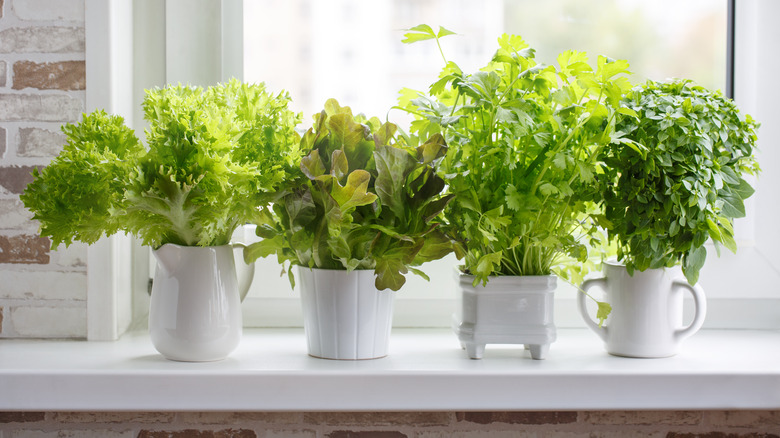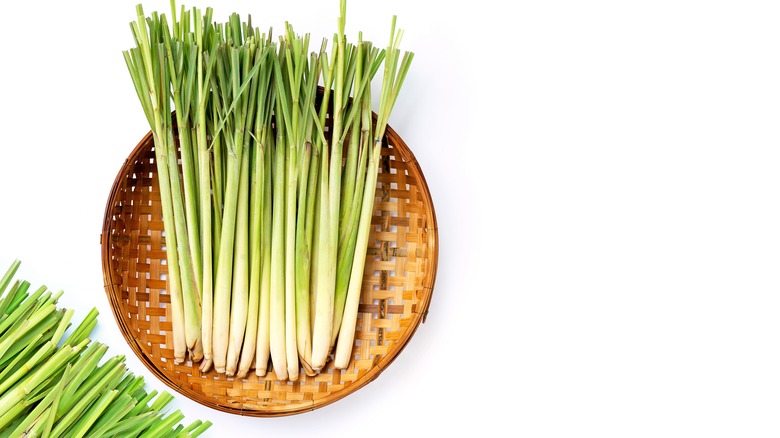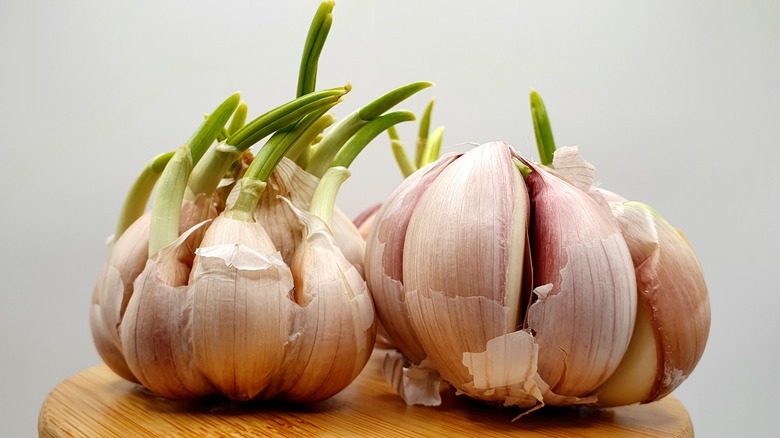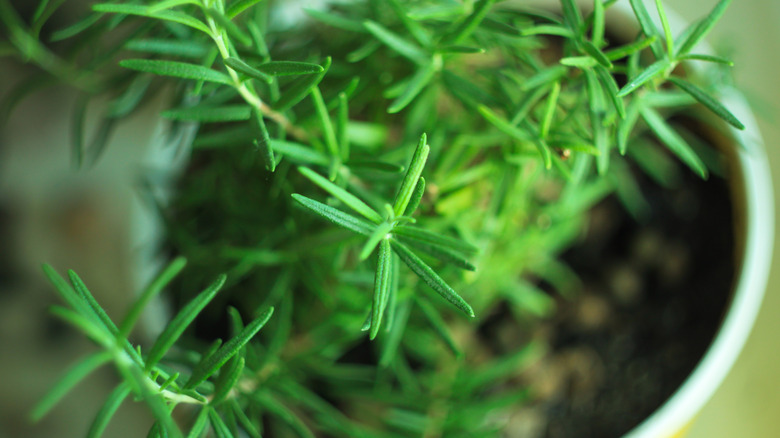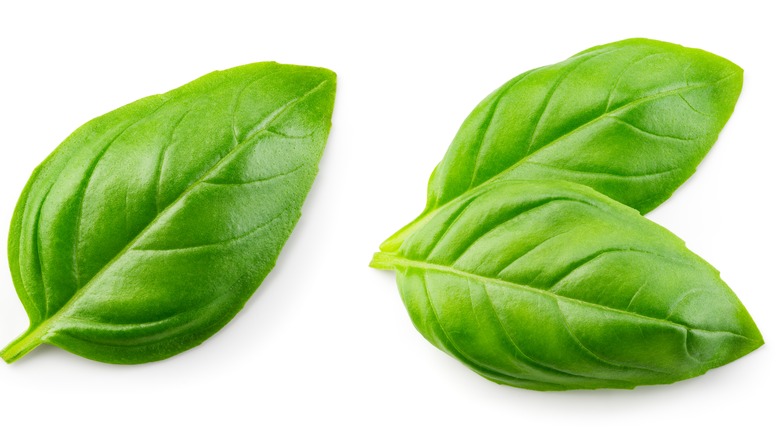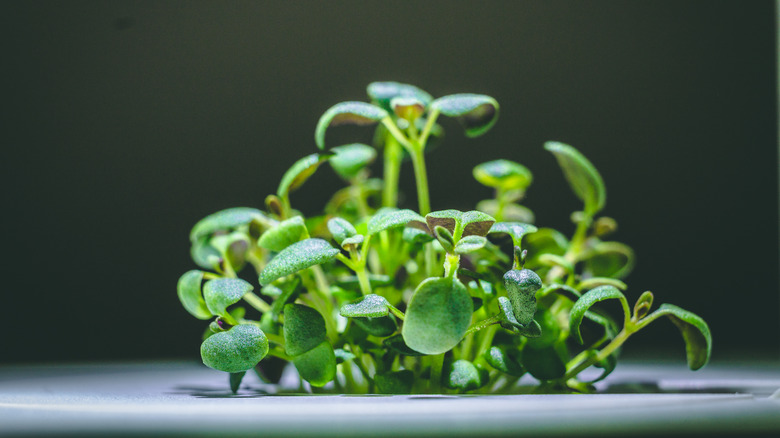Five Herbs Anyone Can Grow In Their Winter Kitchen Window Garden
Mary Oliver once poetically wrote about someone she loved bringing her a box of darkness that turned out to be a gift. In the cold weather of winter, we could use a little of that sentiment to face the dark, chilly mornings.
Fortunately for gardeners, plants do the yeoman's labor of keeping hope and health alive, even through the long winter months. Looking for a kitchen boost that has a legitimate shot at making a difference this winter? Growing a mini herb garden could do the trick. The gift of winter is that gardens become shrunken, strategic, manageable tufts of indoor herbs that, with a little coaching, anyone can grow on a windowsill.
The aroma can calm us down, says Herbs At Home, and just the sight of green growth can jumpstart our cognitive gears for the day. Not to mention, herbs are delicious additions to anything we are trying to concoct in the kitchen, plus they have health benefits galore. That said, we still have to pull off the task of getting them from sprout to usable ingredients. With a few tips, that should be simple enough.
Lemongrass for winter fever, aches, and immunity
Native to Asia, Africa, and Australia, lemongrass (Cymbopogon citratus) prefers warmer temps, but according to New Directions Aromatics, it's an herb that'll work with us in the winter months too. Lemongrass gives a citrus boost to any soup, salad, or tea. It thrives in full sun, says Miracle-Gro, so if your kitchen window faces south, that's handy. This herb likes up to eight hours of sunlight daily and prefers to steer clear of any drafty window.
To add lemongrass to your windowsill herb garden, start by first placing the ends of a few blades of lemongrass in a cup of water and put it in a warm, sunny spot. After a week or so, roots should appear. Plant the rooting lemongrass blades into your windowsill mini pot, completely covering your lemongrass roots with moist, not wet, well-draining potting soil. Water regularly when your topsoil gets dry, adding just enough liquid so it drips out the drainage holes into the pot draining tray.
As your lemongrass develops leaves, consider trimming and setting aside to dry, then adding to your morning hot tea. The lemongrass stems can also be clipped and then chopped up into soups, stir-fries, and more.
Garlic for improved winter heart health
Garlic (Allium sativum) takes months to grow, but there's a faster way to leverage this herb for your windowsill garden — garlic plant parts. According to Green Home Remedy, you can have a few snips of edible garlic plant parts, like green leaves that taste like green onions (only better), available within just a few weeks of planting.
To do this, start with garlic bulbs and gently separate out the cloves. Plant two or three in your mini windowsill pot with relatively loose soil that has a bit of perlite to enable an even amount of moisture and drainage. Tuck them down around 3 inches deep and water thoroughly. After that, water only lightly to avoid rot. Within seven to 10 days, little garlic greens will sprout substantively enough to be snipped.
After snipping leaves off each sprout a few times, plant a new clove to start the process again. If you are patient enough to wait for the garlic stalk to grow taller until it curves into a long malleable stem, you can clip the whole stem for chopping into your favorite soup or salad. However, if you wait so long that the stem flowers, that's a sign that particular sprout will no longer provide any additional leaves.
Rosemary for less winter stress
Rosemary (Rosmarinus officinalis) is an herb known for relieving stress, says Mount Sinai — just don't get stressed trying to grow it on your windowsill because it can be finicky. Nevertheless, the delicate pine scent and immune-boosting benefits of rosemary are worth the work.
According to Grow A Good Life, rooting a rosemary cutting can take a few weeks and up to a month, but you can shorten the process to just a few weeks if you keep the cutting warm and change the water out regularly to avoid any rot. To get started, find a hardy clump of rosemary from your local farmer's market or nursery. Choose one that does not have a woody, thick stem. That's an indication it is an old plant. Pick a few stems to trim the lower leaves, then place them in a cup of water and set them in a warm spot out of direct sunlight. Once you see four to six roots on each stem that measure around ½ an inch, you can plant in your mini-windowsill pot, per Grow A Good Life.
Rosemary does best in a sandy cactus soil blend, or you can mix sand into a traditional potting mix. Plant your rooting rosemary cuttings into the soil carefully, then water thoroughly. Place on your sunny windowsill to get direct sunlight for up to six hours a day. Once your rosemary hits around 6 inches tall, feel free to start snipping the stems for cooking.
Basil because it just tastes so good!
Basil (Ocimum basilicum) comes in sweet, Greek, Thai, cinnamon, or lettuce varieties, says Healthline, but sweet basil is the most popular for Italian dishes and most often what we find at the market. Studies hint that basil has health benefits for everything from memory loss to reducing blood pressure. However, most experiments have been conducted with copious amounts of the herb rather than the pinch and few leaves tossed into typical pesto or pizza recipes. Nevertheless, this herb makes a good pasta sauce great, and that is reason enough to add it to any windowsill herb garden.
According to The Kitchn, take several 4-inch cuttings of basil (choose those that have not yet flowered) and place them in water for about a week until roots begin to form. Use a good, neutral pH potting soil to plant your newly rooted basil cuttings into and tamp the soil around your new plant.
An east-facing kitchen window is handy for your basil not to get a minor singe from unrelentingly direct sunlight, per The Kitchn, but a warm spot with direct sun for six hours a day is your best shot at intensely flavorful basil. Water when topsoil is dry. Avoid dousing the leaves and aim for the base.
Snip as soon as you see leaves and as often as you like after that –especially before you see any blooms — but save about a third of the plant, so it keeps generating harvestable leaves.
Thyme for lowering winter blood pressure
Medical News Today calls thyme (Thymus vulgaris) a versatile Mediterranean herb good for everything culinary, from eggs, poultry, and seafood to soups and salads. Thyme contains thymol, a compound known for cutting down on susceptibility to certain bacteria and viruses. Even low concentrations of thyme oil reportedly showed itself to be a natural food preservative in a study by the Center for Studies of Animal and Veterinary Sciences in Portugal. Not to mention it's historically passed as an insect repellant, an antiseptic, and an ancient embalming agent.
The modern use of thyme as a winter windowsill herb stems from the fact that it is easy to grow and offers a distinct flavor to your best winter dishes. Gardening Know How suggests you start your thyme from cuttings where you see a little node on the stem where leaves are also attached. Root formations have the best shot around that spot, so make a clean cut at the stem under your node, remove any lower leaves, and plant that into your windowsill mini herb pot filled with a soil mix that includes a bit of perlite. Lightly water until the soil is damp and place it in a warm spot with indirect sun. Try using a mini clay pot for this herb, so its roots sufficiently dry out between watering.
Keep in mind that if an herb doesn't take, don't worry. Let it go! There's no guilt in gardening, least of all through winter.
